#Released: September 25 1967
Text
The Doors - I Can't See Your Face In My Mind
#The Doors#Strange Days#I Can't See Your Face In My Mind#Released: September 25 1967#Genres: Rock/ Psychedelic Rock/ Rock and Roll/ Acid Rock/#Classic rock#60's#USA
110 notes
·
View notes
Text
A theory on the creation of Anime Goemon and why he is a different person from Manga Goemon

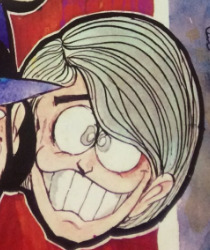
oh boy this is going to be long
First, we must look closely at Chapter 5 of the original manga. It is titled “Suspense Zone” and it is based off of the Arsène Lupin story of the Devil’s Red Ring.

The chapter was originally the 8th Chapter of the manga before being reordered in later publications, and it released in September 28, 1967. I suggest you give it a read for yourself.
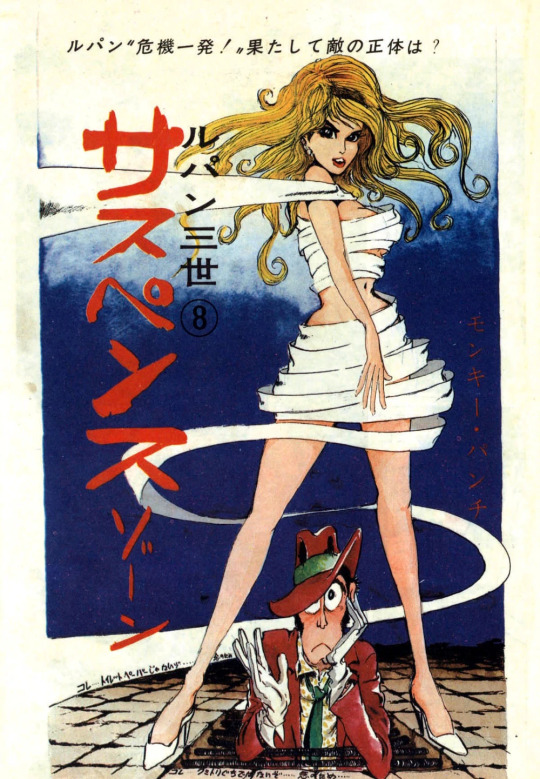
The Red Ring functions differently here, however, in that it periodically transforms the victim into somebody else, almost like their opposite. In this chapter, it is Mr. Danshiyaku, the criminal who aims to take over the country by controlling the Yakuza, who transforms into the master hitman, Master Koroshi. In sticking with Monkey Punch’s interest in Western culture contrasting with Eastern culture, we see the Western Danshiyaku become his opposite, the Eastern Koroshi.



Lupin decides to work with Master Koroshi, asking him to kill Danshiyaku to prevent his takeover, but by a cruel fate, Koroshi is killed in a trap created by Danshiyaku. It is then that Lupin reveals they are really the same person.
Master Koroshi’s outfit, long face, hairstyle, sanpaku eyes, the lines beneath the eyes to show age, and his habit of closing one eye resemble that of Anime Goemon’s, don’t they?

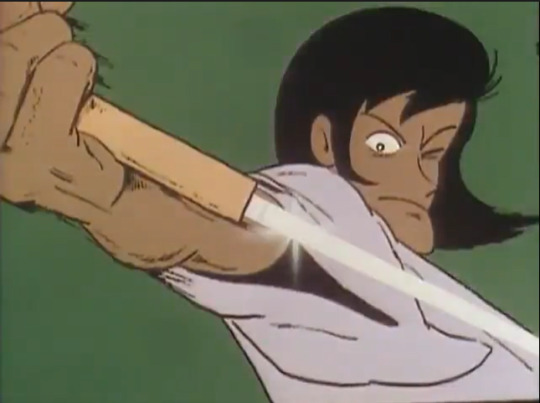

Gone are details like the big eyes, thick eyebrows, long eyelashes, the kimono with the cross pattern resembling a student uniform, etc.

This dramatic scene where he walks out is the same too. Also similar to Anime Goemon, Koroshi has moments of shock where he breaks character like here.

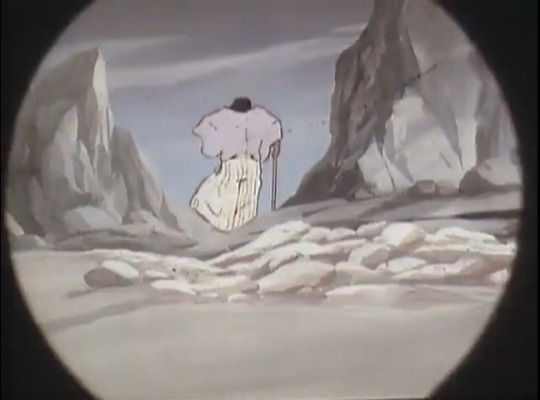

That is because Anime Goemon is based off of Master Koroshi, not Manga Goemon!

For that we must look at when planning began for the Pilot. Yasuo Otsuka stated it was in the summer of 1968, with the idea for a Lupin anime being first proposed around July 25 (you’ll see how this lines up with Goemon’s introduction to the manga soon enough). Yutaka Fujioka, however, stated in an interview in 1978 that it was started 12 years ago in the summer of 1967 when he was 39 years old, but these numbers do not line up unless 1967 is changed to 1968. Perhaps it was some kind of mistake with his memory.
After planning, the team would put together a Pilot loosely adapted from the chapter “Triple Play” released in October 3, 1968, and “Camera Tricks” released in October 17 of the same year.
At the time of planning for the Pilot, however, Goemon was not yet a friend to Lupin in the manga. The serial drama that introduced Goemon as an enemy to Lupin ran in 1968 from April 4 to April 25, but the ending 4th chapter to it had not yet resolved the conflict between them. After this series, there was a break before Goemon would appear again.
In fact, Monkey Punch has stated in an interview for Weekly Manga Action on May 20, 2004, that Goemon was originally never going to be a friend to Lupin, remaining an enemy until the very end. For these reasons, Goemon was not planned to appear in the Pilot.
It was only until August 15 to August 29 in the Kobudo series that Monkey Punch had resolved the conflict between Lupin and Goemon, changing his mind to make them instead friends to also help push the oriental feeling of the manga.
Goemon was created to bring a more Japanese-like character into the series. He is first introduced as resentful of Western ideals, and Lupin on the other hand disregards Eastern ideals. It’s until the second series that they both start learning to accept each others’ cultures, and Goemon decides to reject his masters. His masters tell him his idea of mixing together previous fighting techniques into a new one is a terrible idea simply because they do not wish to accept any new cultural ideas, but they also cannot accept Lupin simply being just as strong with his newer techniques either, and so they provide him with arbitrary advice and even try to make him cold-hearted, to which Goemon responds with:
"I appreciate your advice so far.
But all you have is the past that you have experienced. On the contrary, I have the future that I am about to experience. Do you understand? That is the difference between us!!"
tokyopop changed this line for no reason btw

This change of mind was late into planning for the Pilot, and so it was too late. Suddenly, Goemon was now a part of the main 5 and the staff had no idea what to do.
The staff had put together the plan for the Pilot with the focus of highlighting the dynamic between Lupin and his dedicated partner Jigen, but if they were to add Goemon into this dynamic, where would he belong?
Monkey Punch tends to develop his characters further and exemplify specific traits as time goes on, but at the time of the manga, the only dynamic Jigen and Goemon could provide as a trio to Lupin was simply serving to him as a gunman and swordsman. The staff needed to somehow figure out how Goemon would bring something new to the dynamic without interfering with what they had already established for the pilot.
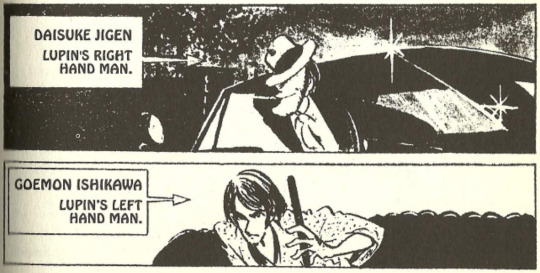
The staff was very dedicated to sticking to the source material, but they could not bring in Manga Goemon as he was, so they proposed an idea, what if they instead modeled Goemon off of Koroshi? He would still be a character based off of Monkey Punch’s manga, and his interactions with Lupin are strong enough to bring over. The planning team may have been under stress due to this, and so this seemed like an easy solution.
Also, considering that Koroshi as a character helps represent the Eastern vs Western clash, like Goemon, it would be reasonable to think that he may be MP’s prototype to Goemon. Given how MP fleshes out his characters over time, the staff would tend to try to predict these by exaggerating specific character traits, so perhaps by exaggerating Goemon’s samurai-like qualities and aging him up, he would serve as a greater contrast to Lupin and perhaps become as how MP would develop him later on. Obviously that was not the case in the manga, as MP would stick with Goemon representing a theme of acceptance of both past and future.
It is due to this that in the anime, Goemon sticks with his culture completely, and so it is him who is rejected by his master, who tries to kill him. The staff created Goemon with the intent of him never changing his mind about cultural values, and so although Goemon does join Lupin regardless, the theme originally told in the manga of acceptance is left incomplete.
The anime does try to toy with this idea of Goemon accepting other culture, such as when he is first introduced he secretly listens to the radio when he doesn’t think his master is there, or those few times in Part 2 where he is willing to try something new, but it tends to be dropped immediately in favor of far more moments where he is instead stubborn.
There are other ambiguities that the anime and pilot would seek to resolve too. Goemon’s sword is made to be the Zantetsuken, the iron cutting sword, before his sword is later to be explained in the manga as the Takemitsu, a bamboo sword his family passed down, and in Shin Lupin it is the Ryusei, the sword of a shooting star. Due to Zantetsuken’s creation as this sword capable of cutting nearly everything, maybe done as to provide more emphasis on the alchemy formula Lupin wishes to steal and to simplify Goemon’s ability, there became more focus on Goemon’s sword itself, with his character in many adaptations only existing to cut things, but the manga focuses more on it being his sheer strength that allows him to cut steel with bamboo, and even tear a person apart in hand to hand combat. I mentioned in the past too that in Shin Lupin, there is even a moment where he cuts steel without Ryusei but with an ordinary sword.
Additionally, the manga only makes it clear that Goemon is the descendant to the legendary thief Ishikawa Goemon, but the pilot adds that he is the 13th of his family to hold the name.
Now, let’s look at the unique relationship that Koroshi provides for Anime Goemon to model.
In the anime, Goemon tends to work on his own, leaving Lupin if he does not agree with a plan. The pilot also describes him as a lonely, wandering man. This is pulled from details from Koroshi such as here, where Lupin describes Koroshi as a “recluse.”
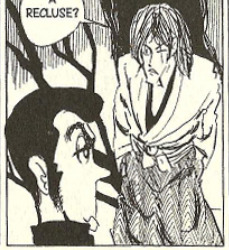
what happened to lupin’s face oh my god
There is also here where Koroshi refuses to follow Lupin because he believes it is nonsense. Unlike Jigen, he serves as a partner who only acts in his own interests.

He’s just as irritable as in the anime, where Lupin describes him in the opening as someone who is scary when angry. This irritability works well with his disdain for Western culture.

In the pilot, there is a detail where when Lupin is made aware that his wine was poisoned, and he states that Goemon would not be the kind of person to do such a thing. Goemon is portrayed as wanting a fair 1 on 1 duel with Lupin, which is also reflective of Koroshi, who wants a fair 1 on 1 duel with Danshiyaku.

It could also be thought by the staff that Koroshi and Lupin would work well together because of the respect and similarities they share, which would also help explain them not fighting anymore.
They both leave behind written challenges as dignified criminals, and in the anime, Goemon insists on challenging Lupin in such a formal manner, unlike in the manga where he just appears constantly to attack by surprise when Lupin would rather not.

Lupin also pities him throughout the chapter, and in the anime when Goemon is introduced, Lupin looks down upon him and his belief in his sword technique.
Also, the anime frequently has moments where Goemon seemingly appears from nowhere to rescue Lupin when he is about to die, and Koroshi does the same too.
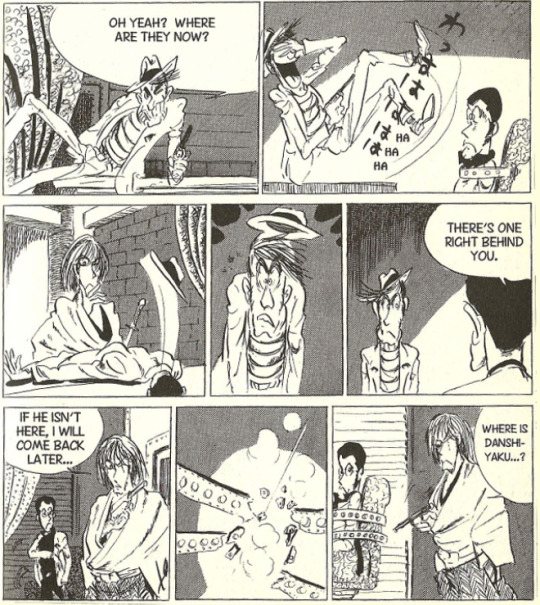
Yes, Danshiyaku wielded a gun in the manga, but to make him more samurai-like for Goemon they gave him the sword. In general, you can see that the anime, even in its adaptation of when Goemon is first introduced, changed his manner of speech significantly and added certain lines to give Goemon a more hostile, but samurai-like feel.
There exists a scene only in the anime in the episode in which Goemon is first introduced, where Fujiko lies to Lupin saying that Goemon took advantage of her. This is actually the opposite as Goemon is naive and gets nervous around women.

This is a scene and character trait pulled from Danshiyaku, and given that he exists as the opposite to Koroshi, the staff figured how Koroshi would act towards women and applied this to Anime Goemon, which is unlike that of Manga Goemon who keeps his composure.

In a way, this would create an interesting dynamic for him between Lupin, who is a womanizer, and Jigen, who dislikes women.
They also based the relationship off of Koroshi because they were unsure of how to explain Manga Goemon suddenly becoming friends with Lupin. In the original manga it’s not explained very well and played off as a joke as to why Lupin went from being very annoyed of Goemon’s antics to taking him in, and it doesn’t help either that Lupin had murdered Goemon’s friend, Majin. Goemon obviously wanted to learn from someone new, but it seems strange that he would forgive so easily, and Lupin doesn’t exactly have much going for him working with Goemon either.
One could say that MP focuses more on the fun of a concept rather than the explanation for it. Many of his stories simply exist as what-if situations, but given how this story is meant to be treated as canon, the staff insisted on something more logical, and with the other reasons for adding Koroshi in, he seems to also provide his own explanation for working with Lupin, with it being a mutual respect. Manga Goemon is younger than Lupin, and so their friendship begins at first as instead him respecting Lupin like he is his master.

To portray this older Anime Goemon, the staff picked a voice actor that would sound older and more mature to fit the samurai tone, with Goemon even sounding older than Lupin.
To quote Monkey Punch on Anime Goemon in comparison to the original:
“In the anime, he's changed a lot, but he's really more like a young boy.“
The truth, however, is that Koroshi was never even MP’s prototype for Goemon. The real prototype was Nitenzi Ondo of Western Samurai.

He looks and acts much closer to the bright and cheerful Manga Goemon, who seeks out justice for others and hates needless killing, and unlike Koroshi, these two both speak in a tone that is very un-samurai like. The theme of this work was that of a young samurai stumbling upon Western society, making friends and enemies in the process as he got accustomed to this new life while also bringing a part of his old life. The focus is on how Western and Eastern cultures clash and work together, and it is also the precursor to Bakumatsu Yankee.

Monkey Punch had wanted a more Japanese feeling to his Lupin manga, and given that Western Samurai had been released only 3 months prior to Goemon’s introduction, Monkey Punch had decided to bring Nitenzi Ondo to the world of Lupin under a new name, Ishikawa Goemon.
Monkey Punch contemplated between a the names of famous Japanese thieves such as Nezumi Kozo, of which the Nezumi clan would later become a frequent villain group in the manga, or Ishikawa Goemon, and it was decided on Goemon because there was another famous manga at the time using the name Nezumi.
Notice how Manga Goemon’s design was not actually based on the original Ishikawa Goemon, and rather that influence is by name only. Manga Goemon’s real influence is of the film Moeyo Ken and its character, the young Okita Souji, who Monkey Punch would later portray in Bakumatsu Yankee. Nitenzi Ondo’s sword was also changed to appear more like a cane for Goemon, reflective of the film Zatoichi that also helped inspire him.
So, if this mistake occurred with the Pilot, why is it that the anime simply did not correct itself? Well the issue lies in that Part 1′s production was based around using the Pilot and whatever extra work that staff may have also left behind as their primary base for the Anime rather than the manga. The style of the Pilot was changed to that of Part 1, and so the new staff was reinterpreting Pilot Goemon, thus pushing him further away from the Manga original.
When Part 1 later became popular, it would be difficult for the Part 2 team to move away from this. Early Part 3 interestingly tries to combine the two, perhaps in an effort to slowly push him back to the source material, but over time his design began to lose the traits of his Manga version until it became like the more popular Part 2, which tends to be used for inspiration more.
Most Lupin adaptations, out of fear of him not being recognized by the audience as Goemon, simply avoid using the manga as a reference. Given that the anime also titles Goemon as a samurai, which the manga does not, there is also more push for him to act as one.
Personally, I think Anime Goemon is a very fun character to have around in the franchise, but it does upset me as someone who really likes his Manga counterpart more. I wish the Anime version’s existence wouldn’t prevent the Manga version from existing in an adaptation at all. When there is any influence from the manga, there always seems to be bias from the previous anime, but it’s very apparent that they are 2 completely different people, rather than just different interpretations of the same person. I feel that it’s also important when looking at his Manga character to not see it with the bias of the Anime because it seems then as if his character is very inconsistent, when it really isn’t. I hope someday he’ll be properly animated.

I used these sources:
https://ameblo.jp/moromorokerro/entry-11914894998.html (this explained most of it already and was a huge help)
http://lupinthepunch.web.fc2.com/monkey/
http://typerlpn3.web.fc2.com/sub1_1.htm
#lupin iii#monkey punch#goemon ishikawa xiii#manga#原ゴエ#anime#lupin the third#this took me forever oh my god
178 notes
·
View notes
Text
Official Akira Pre-movie Timeline
Character childhoods, historical events etc.
hiiii Akira tumblr, I haven't been around here much but here's a translation I did. I've never seen this full timeline translated anywhere, so maybe it'll be of interest !😳
(I did a condensed version on Twitter a while ago, but I figure it's easier to follow in its original format .)
(Long post under the cut)
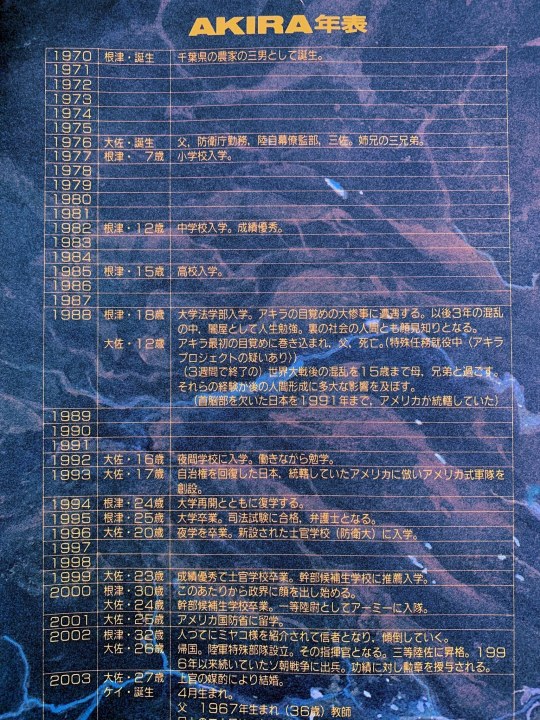
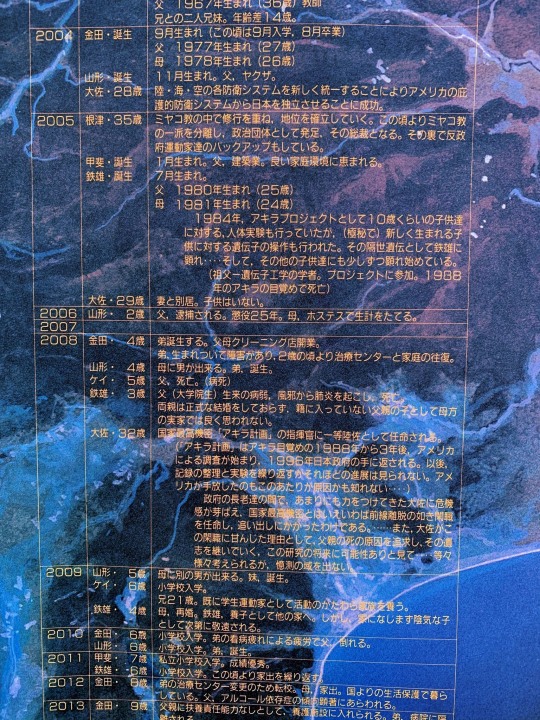
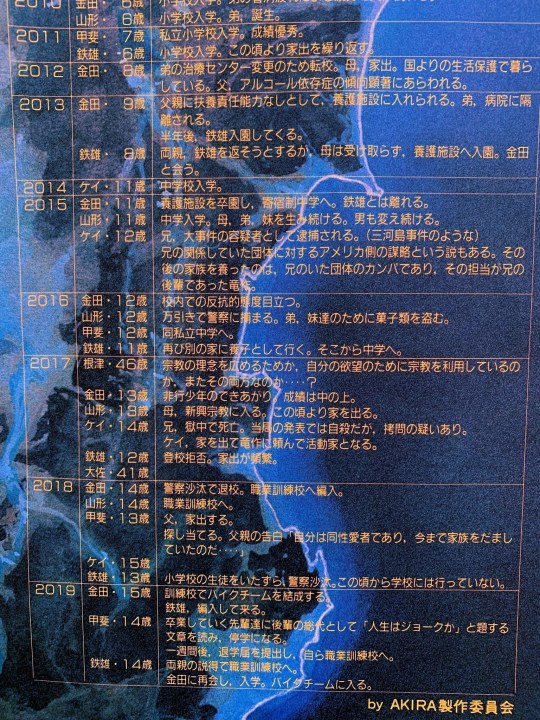
Source is the book Poster & Graphic Akira released in 1988. Also a special thank you to my old friend Shina-san for the photos from the book, I don't yet own a copy myself !!
1970
Nezu's birth - Born in Chiba as the third son of farmers.
1976
Colonel's birth - Has an older sister and an older brother. His father served in the Japan Defense Agency, JGSDF major.
1977
Nezu age 7 - Started elementary school.
1982
Nezu age 12 - Started middle school. Excellent grades.
1985
Nezu age 15 - Started high school.
1988
Nezu age 18 - Started law school. The disaster of Akira’s awakening occurred. In the chaos of the next 3 years, he studied life as a black marketeer. During that time he became acquainted with the people of this underworld.
Colonel age 12 - His father died to Akira’s first awakening. (He was on a special mission, suspected to be related to the Akira Project). After the world war (which ended after 3 weeks), until he was 15 he spent the next years of chaos with his mother and siblings. These events would profoundly shape his later development. (Until 1991, Japan lacked a governing body and was controlled by the US)
1992
Colonel age 16 - Started night school. Studied while working.
1993
Colonel age 17 - Having regained autonomy, Japan emulates the US and establishes an American-style military.
1994
Nezu age 24 - As university resumed operation, he returned to school.
1995
Nezu age 25 - Graduated. Passed the bar exam, and became a lawyer.
1996
Colonel age 20 - Graduated night school. Enrolled in the newly established military academy (National Defense Academy).
1999
Colonel age 23 - Graduated military academy with excellent grades. Admitted to Officer Candidate School on recommendation.
2000
Nezu age 30 - From around this time he begins to appear in politics.
Colonel age 24 - Graduates from Officer Candidate School. Enlists in the Army as a First Lieutenant.
2001
Colonel age 25 - Studies abroad at the US Department of Defense.
2002
Nezu age 32 - Hears about Miyako-sama, and becomes a devoted believer.
Colonel age 26 - Returns to Japan. Establishes the Army Special Forces. Becomes its commander. Promoted to Major. Dispatched in the Soviet-DPRK War, which had been ongoing since 1996. He is awarded a decoration for his service.
2003
Colonel age 27 - Through matchmaking by his superior officer, he gets married.
Kei - Born in April. Her father, born 1967 (age 36), is a teacher. She has an older brother. They're 14 years apart.
2004
Kaneda - born in September (at this time, schools would have September enrollment and August graduation). His father born 1977 (age 27). His mother born 1978 (age 26).
Yamagata - born in November. His father is a Yakuza.
Colonel age 28 - By creating a new unification of land, sea, and air defense systems, he successfully allows Japan to gain independence from the US protective defense system.
2005
Nezu age 35 - He trains diligently under Miyako, and establishes himself. From around this time he separates under a new sect of Miyako's religion, and starts a political organization, becoming its president. Behind the scenes he is backing anti-government activists at the same time.
Kai - Born in January. His father works in the construction industry. He is blessed with a good home environment.
Tetsuo - Born in July. His father born 1980 (age 25). His mother born 1981 (age 24). In 1984, as part of the Akira Project, experiments were conducted on children around the age of 10, and genetic manipulation was (secretly) performed on newly born children. The effects of this skipped a generation and manifested in Tetsuo… and are gradually beginning to show in other children.(His grandfather was a genetic engineer. He participated in the Project. He died during Akira's awakening in 1988)
Colonel age 29 - He and his wife separate. They have no children.
2006
Yamagata age 2 - His father is arrested. He will serve 25 years. His mother makes a living as a hostess.
2008
Kaneda age 4 - His little brother is born. His parents open a laundry service. His little brother is born with a disability, and goes between home and treatment centers since the time he's 2 years old.
Yamagata age 4 - His mother gets a boyfriend. A little brother is born.
Kei age 5 - Her father dies. (Illness)
Tetsuo age 3 - His father (a graduate student), who's been sickly since birth, develops pneumonia from the common cold, and dies. His parents were never officially married, so as his father's child born out of wedlock, he's poorly received by his mother's side of the family.
Colonel age 32 - He is appointed commander of the nation's top secret 'Akira Plan' as Colonel. (The 'Akira Plan' began 3 years after Akira's awakening in 1988, when the US began investigating, and in 1996 it was turned over to the Japanese government. Since then, despite organization of records and repeated experiments, there hasn't been much progress. This may be why the US let go of it….) The heads of government began to feel threatened by the Colonel's excessively growing power, so even though it was a top national secret, they appointed him to this do-nothing position to force him to withdraw from the front lines, as a means of dismissal. …As for why the Colonel resigned himself to this sinecure, perhaps it's because he was seeking answers about his father's death, or trying to fulfill his father's dying wish, or maybe he himself saw potential in this investigation…. There are various possibilities, but one can only speculate.
2009
Yamagata age 5 - His mother gets another boyfriend. A little sister is born.
Kei age 6 - Starts elementary school. Her older brother is 21. He's already a student activist while also supporting the family.
Tetsuo age 4 - His mother remarries. Tetsuo is adopted by another family. But he can't get used to his new home and is gradually shunned as a gloomy child.
2010
Kaneda age 6 - Starts elementary school. Due to the fatigue of nursing his younger brother, his father collapses.
Yamagata age 6 - Starts elementary school. Another little brother is born.
2011
Kai age 7 - Starts private elementary school. Gets excellent grades.
Tetsuo age 6 - Starts elementary school. At this time he starts repeatedly running away from home.
2012
Kaneda age 8 - Changes schools due to his little brother changing treatment centers. His mother runs off. They live off of government assistance. His father shows a distinct turn towards alcoholism.
2013
Kaneda age 9 - His father is deemed unfit to take care of the children, so Kaneda is sent to an orphanage. His little brother is kept at a hospital. Half a year later, Tetsuo comes to the orphanage.
Tetsuo age 8 - His parents try to return him, but his birth mother won't accept him, so he's sent to an orphanage. He then meets Kaneda.
2014
Kei age 11 - Starts middle school.
2015
Kaneda age 11 - Graduates from the orphanage and goes to a boarding middle school. He's separated from Tetsuo.
Yamagata age 11 - Starts middle school. His mother continues to have children, both boys and girls. She also keeps changing boyfriends.
Kei age 12 - Her older brother is arrested as a suspect in a major incident. (Something like the Mikawashima train crash). There are rumors that it was a US plot against the organization her older brother was connected to. Following this, Kei's family was supported by donations from her brother's group, organized by her brother's junior, Ryusaku.
2016
Kaneda age 12 - His defiant attitude stands out in school.
Yamagata age 12 - Caught by the police for shoplifting. He was stealing sweets for his little siblings.
Kai age 12 - Goes to the same private academy for middle school.
Tetsuo age 11 - He's adopted again by another family. He then starts middle school.
2017
Nezu age 46 - He may be doing it to spread the religion's ideals, or he may be using the religion for his own desires, or perhaps both….?
Kaneda age 13 - A complete juvenile delinquent. His grades are above average.
Yamagata age 13 - His mother joins a new religion. He leaves home.
Kei age 14 - Her older brother dies in prison. The authorities claim it was a suicide, but it's suspected that he was tortured. Kei leaves home and asks Ryusaku if she can become an activist too.
Tetsuo age 12 - Becomes truant. Frequently runs away from home.
Colonel age 41
2018
Kaneda age 14 - Expelled after a brush with the law. Starts at vocational school.
Yamagata age 14 - Starts at vocational school.
Kai age 13 - His father runs away from home. They find him. His father confesses: "I'm gay, and have been deceiving our family this whole time…."
Kei age 15
Tetsuo age 13 - Due to misconduct with an elementary school student, he gets in trouble with the police. From this point forward he stops going to school.
2019
Kaneda age 15 - Forms a motorcycle team at the vocational school.
Tetsuo enrolls.
Kai age 14 - As junior representative, he reads an essay titled 'Is Life A Joke' to the graduating seniors, and is suspended. One week later, he turns in his notice to withdraw, and enrolls in vocational school himself.
Tetsuo age 14 - His parents convince him to go to vocational school. He reunites with Kaneda, and is admitted. There, he joins the motorcycle team.
#akira 1988#AKIRA#translation#nezu#colonel shikishima#kei#kaneda#yamagata#kai#tetsuo#ryusaku#kaneda shotaro#tetsuo shima
191 notes
·
View notes
Text

David Soul (born David Richard Solberg; August 28, 1943 – January 4, 2024) Actor and singer known for his role as Detective Kenneth "Hutch" Hutchinson in the television series Starsky & Hutch from 1975 to 1979; Joshua Bolt on Here Come the Brides from 1968 to 1970. As a singer, he scored one US hit and five UK hits with songs such as "Don't Give Up on Us" (No. 1 in US, Canada, and UK) in 1976 and "Silver Lady" (No. 1 in UK) in 1977. He also starred in the 1979 hit TV movie adaptation Salem's Lot by Stephen King.
Soul first gained national attention as the "Covered Man" appearing on The Merv Griffin Show in 1966 and 1967, on which he sang while wearing a mask. He explained: "My name is David Soul, and I want to be known for my music." The same year, he made his television debut in Flipper.
In 1967, he signed a contract with Columbia Pictures and following a number of guest appearances, including the episode "The Apple" from the second season of Star Trek, he landed the role of Joshua Bolt on the television program Here Come the Brides with co-stars Robert Brown, Bobby Sherman and Bridget Hanley. The series was telecast on the ABC network from September 25, 1968, to September 18, 1970. In 1972, he co-starred as Arthur Hill's law partner on Owen Marshall: Counselor at Law. Following numerous guest-starring roles on TV, including The Streets of San Francisco.
His breakthrough came when he portrayed Detective Ken "Hutch" Hutchinson on Starsky & Hutch, a role he played from 1975 until 1979. During his career he made guest appearances on Star Trek, I Dream of Jeannie, McMillan & Wife, Cannon, Gunsmoke, All in the Family, and numerous TV movies and mini-series, including Homeward Bound (1980), World War III, and Rage (1980), a TV movie commended on the floor of the U.S. Senate and for which he received an Emmy Award nomination. Soul also starred with James Mason in the 1979 TV miniseries adaptation of Stephen King's Salem's Lot, which was edited and released as a theatrical feature film in some countries.
He continued to make guest appearances in various television series. He starred in the miniseries The Manions of America as Caleb Staunton in 1981. He starred in the short-lived 1983 NBC series Casablanca, playing nightclub owner Rick Blaine (the role that was made famous by Humphrey Bogart in the 1942 film Casablanca), and co-starred in the NBC series The Yellow Rose during the 1983–1984 season. He also starred in the television adaptation of Ken Follett's wartime drama The Key to Rebecca (1985) directed by David Hemmings. He later starred as the infamous Florida robber Michael Platt in the TV movie In the Line of Duty: The F.B.I. Murders (1988), which depicted the 1986 FBI Miami shootout, subsequently used as an FBI training film. Soul also directed the episode "No Exit" of the 1980s TV series Miami Vice. (Wikipedia)
IMDb Listing
#David Soul#TV#Obit#Obituary#O2024#Starsky and Hutch#Here Come the Brides#Casablanca#Salem's Lot#Owen Marshall: Counselor at Law#The Manions of America
23 notes
·
View notes
Text

The Doors - When the Music’s Over (1967)
Jim Morrison / Ray Manzarek / Robby Krieger / John Densmore
from: "Strange Days" (LP)
Art Rock | Proto-Goth
JukeHostUK
(left click = play)
(320kbps)
(26MB | 11:00+/-)
Personnel:
Jim Morrison: Vocals
Ray Manzarek:
Keyboards:
Vox Continental Organ
Fender Rhodes Piano
Keyboard Bass
Robby Krieger: Guitar
John Densmore: Drums
Produced by Paul A. Rothchild
Remastered by
Bruce Botnick / Paul A. Rothchild / The Doors
Recorded:
@ Sunset Sound Recorders
in Hollywood, California USA
May–August 1967
Album Released:
on September 25, 1967
Elektra Records
Rhino Records:
2007 CD Reissue
#The Doors#Doors#When the Music’s Over#Strange Days#Elektra Records#1960s#Jim Morrison#Ray Manzarek#Robby Krieger#John Densmore#Proto-Goth#Art Rock
6 notes
·
View notes
Text
Crimes That Shook Britain (West Midlands)

Murder of Charlene Ellis and Latisha Shakespeare
Best mates Letisha Shakespeare, 17, and Charlene Ellis, 18, were shot as they left a party in Aston, Birmingham, in the early hours of 2 January 2003.
Charlene’s twin Sophie, their cousin Cheryl Shaw, and friend Leon Harris were injured by the burst from an illegal submachine gun, fired from a car. The teenagers were innocent victims of a bitter gangland feud between the Johnson Crew and Burger Bar Boys.
Charlene’s half-brother Marcus Ellis, 24, along with Michael Gregory, 23, Nathan Martin, 26, and Rodrigo Simms, 20 - all alleged members of the Burger Bar Boys - were convicted of the murders and jailed for life.

The Black Panther
Donald Neilson was a burglar but, in 1967, moved on to armed robberies of post offices and - in 1974 - murder.
Within nine months, he’d shot dead sub-postmasters Donald Skepper, Derrek Astin and Sidney Grayland during almost identical robberies. The media dubbed the balaclava-wearing killer the ‘Black Panther’.
In January 1975, he kidnapped heiress Lesley Whittle, 17, in Shropshire, and demanded £50,000 ransom but never got the money. Lesley was found dead months later - hanged in a drainage shaft. Neilson was given four life sentences for the murders. He died in prison in 2011.

Monster of Worcester
Friday, 13 April 1973 - the mutilated bodies of siblings Paul, 4, Dawn, 2, and Samantha Ralph, just 9 months, were found impaled on a neighbor's garden railings.
Police arrested the Ralph family's lodger, David McGreavy, then aged 21. The children's dad Clive had left McGreavy babysitting while he collected his wife, Dorothy from work.
But when Samantha cried, McGreavy - who'd been drinking - flipped and battered her to death.
Next, he strangled Paul, then McGreavy then mutilated their bodies with a pickaxe, before impaling them. In June 1973, David McGreavy pleaded guilty to three murders and was sentenced to life in prison with a minimum term of 20 years.
He was controversially released on parole in December 2018.

Murder of Daniel Pelka
Daniel Pelka, 4, was starved and beaten by his mother Magdalena Luczak, 29, and her boyfriend Mariusz Krezolek, 36, before he died in their Coventry home in March 2012.
Daniel was locked in a room, force-fed salt, and subjected to water torture. Krezolek broke Daniel's arm in 2011, but the couple claimed that he'd fallen off the sofa.
Daniel weighed just 1st 9lb when he died.
Krezolek and Luczak blamed each other but were both convicted of Daniel's murder and jailed for life with a minimum 30-year term. A serious case review found there were missed opportunities to help little Daniel.
Social services had investigated in 2011 and teachers had raised concerns when the underweight child was caught stealing food and eating from bins.
Luczak was found hanged in her cell in July 2015. Krezolek died of a heart attack in prison in 2016.
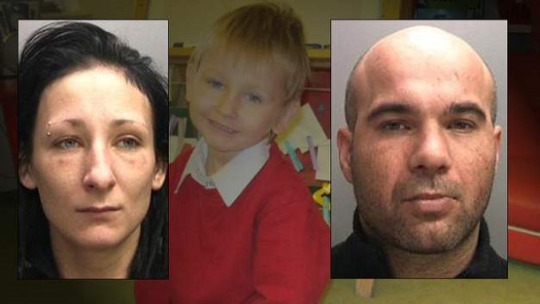
Tracie Andrews
Lee Harvey, 25, was stabbed 42 times in his car on a quiet lane near Alvechurch, Worcestershire. His fiancée Tracie Andrews claimed a man had murdered Lee during a road-rage attack after a three-mile car chase.
Andrews sobbed during a press conference appealing for info, but it emerged that the couple had a volatile relationship, and Andrews could be violent.
Police found the murder weapon hidden in the petrol tank of Lee's car and Andrews was charged with his murder.
Andrews claimed she acted in self-defense, but the court heard that she'd stabbed Lee after a row broke out in the car.
She was convicted of murder and jailed for life. Andrews, was released in July 2011 after serving 14 years of her sentence.

Murder of Naomi Smith
At 9:45 on 14 September 1995, Naomi Smith, 15, went to post a letter for her mum.
Just before midnight, Naomi's father and her best friend found Naomi's half-naked body underneath the slide of a local playground a few hundred meters from her home in Ansley Common, Nuneaton.
Naomi had been sexually assaulted, her throat cut and body mutilated.
DNA found on her body matched that of local man Edwin Hopkins, 19.
During his trial, it was revealed Hopkins had an obsession with knives.
He was convicted of murdering Naomi during a frenzied attack and jailed for life. Hopkins maintained his innocence, but an application to review his minimum term in 2010 was declined.

#murder#truecrime#tc community#tcc family#serialkillers#blog#the crime crypt#true crime community#true crime junkie#west midlands#the black panther#monster of worcester#tracie andrews#daniel pelka#crimes that shook britain#britain
6 notes
·
View notes
Text
Cass Elliot

Ellen Naomi Cohen (September 19, 1941 – July 29, 1974), known professionally as Cass Elliot, was an American singer. She was also known as "Mama Cass", a name she reportedly disliked. Elliot was a member of the singing group the Mamas & the Papas. After the group broke up, she released five solo albums. Elliot received the Grammy Award for Best Contemporary (R&R) Performance for "Monday, Monday" (1967). In 1998, she was posthumously inducted into the Rock and Roll Hall of Fame for her work with the Mamas & the Papas. via Wikipedia
youtube
Cass Elliot - Dream A Little Dream Of Me (It's Lulu, 07/25/1970)
1 note
·
View note
Text

Inez Foxx (September 9, 1937 – August 25, 2022) and her elder brother Charlie Foxx (October 23, 1933 – September 18, 1998) were a rhythm and blues and soul duo from Greensboro. She sang lead vocal, while Charlie sang back-up and played guitar. Casey Kasem, and doubtless many others, mistakenly thought that the two were husband and wife.
Both children were born in Greensboro to John and Peggy Fox. They changed their professional names to Foxx with a double ‘x’.
Charlie Foxx began singing with a gospel choir as a child in the early 1950s and was joined by his sister. In 1960, she traveled to New York City and recorded for Brunswick Records using the name Inez Johnston, but with little success. In early 1963, the pair introduced themselves to Henry ‘Juggy’ Murray, the owner of Sue Records, and sang him their arrangement of the traditional lullaby “Hush, Little Baby”. The song, re-titled “Mockingbird,” was released by Sue’s subsidiary label Symbol Records in June 1963. The single reached the top 10 on both the US rhythm and blues and pop charts. It was their most successful record, selling over one million copies, and was awarded a gold disc by the RIAA. It was covered by artists including Aretha Franklin, James Taylor, Carly Simon, Dusty Springfield, Etta James with the Taj Mahal, and Toby Keith.
She married songwriter and producer Luther Dixon in the late 1960s. Together they wrote, and produced, the Platters’ mid-1960s return to hit-making with the single “I Love You 1000 Times”. Luther Dixon produced her and Charlie’s 1967 Dynamo album Come By Here, but the couple divorced. #africanhistory365 #africanexcellence
1 note
·
View note
Video
youtube
luni, 3 aprilie 2017
The Doors - Strange Days (Full album 1967)
“Strange Days” is the second studio album by American rock band the Doors, released on September 25, 1967 by Elektra Records. The album was a commercial success, reaching number 3 on the US Billboard 200, and eventually earning RIAA platinum certification. The album contains the Top 30 hit singles "People Are Strange" and "Love Me Two Times".
“Strange Days” este al doilea album de studio al trupei americane de rock Doors, lansat la 25 septembrie 1967 de catre Elektra Records. Albumul a fost un success comercial, atingand locul 3 in US Bilboard 200 si apoi, castigand certificarea de platina de la RIIA. Albumul contine single-urile de Top 30 hits “People Are Strange” si “Love Me Two Times”
List of tracks
Side 1
1. "Strange Days" 3:11
2. "You're Lost Little Girl" 3:03
3. "Love Me Two Times" 3:18
4. "Unhappy Girl" 2:02
5. "Horse Latitudes" 1:37
6. "Moonlight Drive" 3:05
Side 2
1. "People Are Strange" 2:13
2. "My Eyes Have Seen You" 2:32
3. "I Can't See Your Face in My Mind" 3:26
4. "When the Music's Over" 10:58
Personnel
The Doors
Jim Morrison – vocals, percussion, Moog synthesizer on track 1
Ray Manzarek – Vox Continental organ, Fender Rhodes, piano bass on tracks 4 and 10, tack piano on tracks 4-8, harpsichord on track 3 and 6, backwards piano on track 4, marimba on track 9, backing vocals on track 7
Robby Krieger – guitars
John Densmore – drums
Additional musicians
Douglas Lubahn – bass guitar
Technical
Paul A. Rothchild – production, backing vocals on track 7
Bruce Botnick – engineering, backing vocals on track 7
Joel Brodsky – cover photography
William S. Harvey – cover concept and art direction
Jac Holzman – production supervisor
0 notes
Text
𝔗𝔥𝔢 𝔇𝔬𝔬𝔯𝔰 - 𝔘𝔫𝔥𝔞𝔭𝔭𝔶 𝔊𝔦𝔯𝔩
#The Doors#Strange Days#Released: September 25 1967#Genres: Rock/ Psychedelic Rock/ Rock and Roll/ Acid Rock/#Classic rock#60's#USA
26 notes
·
View notes
Text
Events 1.25 (after 1930)
1932 – Second Sino-Japanese War: The Chinese National Revolutionary Army begins the defense of Harbin.
1937 – The Guiding Light debuts on NBC radio from Chicago. In 1952 it moves to CBS television, where it remains until September 18, 2009.
1941 – Pope Pius XII elevates the Apostolic Vicariate of the Hawaiian Islands to the dignity of a diocese. It becomes the Roman Catholic Diocese of Honolulu.
1942 – World War II: Thailand declares war on the United States and United Kingdom.
1945 – World War II: The Battle of the Bulge ends.
1946 – The United Mine Workers rejoins the American Federation of Labor.
1946 – United Nations Security Council Resolution 1 relating to Military Staff Committee is adopted.
1947 – Thomas Goldsmith Jr. files a patent for a "Cathode Ray Tube Amusement Device", the first ever electronic game.
1949 – The first Emmy Awards are presented in the United States; the venue is the Hollywood Athletic Club.
1960 – The National Association of Broadcasters in the United States reacts to the "payola" scandal by threatening fines for any disc jockeys who accept money for playing particular records.
1961 – In Washington, D.C., US President John F. Kennedy delivers the first live presidential television news conference.
1964 – Blue Ribbon Sports, which would later become Nike, is founded by University of Oregon track and field athletes.
1967 – South Vietnamese junta leader and Prime Minister Nguyen Cao Ky fires rival, Deputy Prime Minister and Defence Minister Nguyen Huu Co, while the latter is overseas on a diplomatic visit.
1969 – Brazilian Army captain Carlos Lamarca deserts in order to fight against the military dictatorship, taking with him ten machine guns and 63 rifles.
1971 – Charles Manson and four "Family" members (three of them female) are found guilty of the 1969 Tate–LaBianca murders.
1971 – Idi Amin leads a coup deposing Milton Obote and becomes Uganda's president.
1979 – Pope John Paul II starts his first official papal visits outside Italy to The Bahamas, Dominican Republic, and Mexico.
1980 – Mother Teresa is honored with India's highest civilian award, the Bharat Ratna.
1986 – The National Resistance Movement topples the government of Tito Okello in Uganda.
1990 – Avianca Flight 052 crashes in Cove Neck, New York, killing 73.
1993 – Five people are shot outside the CIA Headquarters in Langley, Virginia. Two are killed and three wounded.
1994 – The spacecraft Clementine by BMDO and NASA is launched.
1995 – The Norwegian rocket incident: Russia almost launches a nuclear attack after it mistakes Black Brant XII, a Norwegian research rocket, for a US Trident missile.
1996 – Billy Bailey becomes the last person to be hanged in the United States.
1998 – During a historic visit to Cuba, Pope John Paul II demands political reforms and the release of political prisoners while condemning US attempts to isolate the country.
1998 – A suicide attack by the Liberation Tigers of Tamil Eelam on Sri Lanka's Temple of the Tooth kills eight and injures 25 others.
1999 – A 6.0 magnitude earthquake hits western Colombia killing at least 1,000.
2003 – Invasion of Iraq: A group of people leave London, England, for Baghdad, Iraq, to serve as human shields, intending to prevent the U.S.-led coalition troops from bombing certain locations.
2005 – A stampede at the Mandhradevi temple in Maharashtra, India kills at least 258.
2006 – Mexican professional wrestler Juana Barraza is arrested in connection with the serial killing of at least ten elderly women.
2010 – Ethiopian Airlines Flight 409 crashes into the Mediterranean Sea off the coast of Na'ameh, Lebanon, killing 90.
2011 – The first wave of the Egyptian revolution begins throughout the country, marked by street demonstrations, rallies, acts of civil disobedience, riots, labour strikes, and violent clashes.
2013 – At least 50 people are killed and 120 people are injured in a prison riot in Barquisimeto, Venezuela.
2019 – A mining company's dam collapses in Brumadinho, Brazil, a south-eastern city, killing 270 people.
0 notes
Text

The Doors- Strange Days
(Psychedelic Rock, Psychedelic Pop, Blues Rock)
Released: September 25, 1967 [Elektra Records]
Producer(s): Paul A. Rothchild
youtube
1 note
·
View note
Text
Thursday, September 14, 2023 8pm ET: Feature LP: Fleetwood Mac - 50 Years – Don't Stop (2018)
50 Years – Don’t Stop is a box set by British-American rock band Fleetwood Mac, released on November 16, 2018, marking 50 years since the band’s formation. Consisting of three CDs, the set spans the history of the band from 1967 to 2013. It was also released as a 5-LP set and a condensed single CD version. Unlike its spiritual predecessor, 25 Years – The Chain (1992), this album does not feature…

View On WordPress
0 notes
Text




Pick 1 album and discuss.
If you don’t recognize any of these, listen to at least 2 first. I will add music 🎶 links in the comments.
#Alsmusiccafe
Episode 146
7 15 23
#VNVNATION #TheDoors #JohnLennon #TaylorAustinDye
1 note
·
View note
Text
Chapter 0, The Fool
I don’t even know where to begin how to tell you I got into the UFO phenomenon. I was raised religious, pretty personal relationship with our Lord and savior style, and came out a staunch materialist atheist, and by that I mean I didn’t see any sign of anything supernatural in my life. I’d spent my existentially-anxious life putting the pieces of how this world worked (tm) together. Lord knows I haven’t done much else in my life. I’m just a regular flipping guy, after all.
Sometime during the Covid lockdown, I found myself looking at the UFO phenomenon after learning that the NYT had had a headline story about a secret Pentagon Unidentified Areal Phenomenon investigative task force, and its lead investigator had resigned in protest.
What the flip? You learn about this guy (his name is Lui Elizando) and he’s been in active senior intelligence operations throughout the Afghanistan War and more, like locating Bin Laden. It’s clear on listening to him that there’s a lot he can’t say. He’s not here to break any oaths, but he wants to tell us something, something very important. He doesn’t seem like a showman, he seems like a patriot, and a father, and a brother, a darn good man just being honest.
Turns out he was part of a company [he left in late 2020] with news-to-me UFO enthusiast Tom Delong from Blink 182 called To the Stars Academy, launching promotional material for books and stuff about, like, UFO stuff. Turns out Tom has a very interesting story, a story that sounds so crazy it sounds made up. But some very serious people take at least some of his beliefs very seriously.
The partners in his company staff made it clear parts of his story were true.
One of his partners in his company is Doctor Harold E. Puthoff. Here’s his profile from a Freedom Of Information Act (FOIA) released CIA profile. Wait, huh?
Document Type:CREST
Collection: STARGATE
Document Number (FOIA) /ESDN (CREST): CIA-RDP96-00787R000100220005-4
Release Decision: RIFPUB
Original Classification: K (unknown)
Document Page Count: 1
Document Creation Date: November 4, 2016
Document Release Date: September 1, 2000
Sequence Number: 5
Case Number:
Content Type: BIO
File:
Untitled Database
Body:
HAROLD E. PUTHOFF
Harold E. Puthoff, M. S. E., Ph.D., 38-year-old specialist in quantum physics, parapsychology, and paraphysical phenomena, came to SRI [that’s ahem Stanford Research Group] in 1972, where he is doing work in the area of lasers and also initiating research in biofeedback and biofield measurements. A patent holder in the areas of lasers and optical devices, Dr. Puthoff has supervised research for Ph. D. candidates in Electrical Engineering and Applied Physics at Stanford University. His publications include a textbook in lasers that is widely used in universities both here and abroad, and over 25 papers in professional journals.
Before joining the staff of SRI, he was a Research Associate at the Microwave Lab and Lecturer in the Department of Electrical Engineering following receipt of his Ph. D. degree from Stanford in 1967. While at Stanford, he conceived, patented, and developed a tunable Raman laser which produces high power radiation throughout the infrared portion of the spectrum. Before entering Stanford, Dr. Puthoff graduated with a Master's Degree from the University of Florida in 1960. He is a native of Chicago. Approved For Release 2001/03/07 : CIA-RDP96-00787R000100220005-4
…
Hang on, what the fuck exactly is going on right now? Why am I reading about this Stanford professor specialist in quantum physics, and what the fuck is parapsychology and paraphysical phenomena?? He’s apparently a laser genius. But why am I reading about this from a specially FOIA-requested release from the CIA?
Because they, them being the CIA, funded his parapsychology and paraphysical phemomena experiments.
I don’t know how to emphasize that for you.
I mean, I know the CIA has done a lot of terrible, far out, and way bad stuff, but what are they doing funding whatever the hell this is?
Here, let me quote from Puthoff’s own Research Paper on CIA-Initiated Remote Viewing At Stanford Research Institute:
One outcome of this change in policy is the government's recent admission of its two-decade-plus involvement in funding highly-classified, special access programs in remote viewing (RV) and related psi phenomena, first at Stanford Research Institute (SRI) and then at Science Applications International Corporation (SAIC), both in Menlo Park, CA, supplemented by various in-house government programs. Although almost all of the documentation remains yet classified, in July 1995 270 pages of SRI reports were declassified and released by the CIA, the program's first sponsor [2]. Thus, although through the years columns by Jack Anderson and others had claimed leaks of "psychic spy" programs with such exotic names as Grill Flame, Center Lane, Sunstreak and Star Gate, CIA's release of the SRI reports constitutes the first documented public admission of significant intelligence community involvement in the psi area.
Don’t worry, we’ll get into it. This rabbit hole is broad and it is deep.
I encourage you to read the whole Research Paper, where he explains how his method for Remote Viewing works, and some of his surprising success stories.
HERE
So this is just one of the interesting guys on this weird To the Stars Academy company’s board.
The other guy is Jim Semivan. And who is Jim Semivan?
Here’s his profile from infamous paranormal extroidinaire radio show Coast to Coast AM:
Links between the CIA and the UFO mystery stretch back to 1947. Two veteran CIA officers, both of whom have expressed personal interest in UFO/UAP issues and cases, joined George Knapp to discuss the CIA's role in the study of UFOs, and their own experiences. Jim Semivan appeared in the first half. He spent 25 years with the CIA and then joined up with other former government insiders as part of Tom Delonge's To the Stars Academy. He detailed how he was inducted into the CIA and learned spycraft, which takes years to master. The CIA works on a "need-to-know" principle, so when it came to UFOs, Semivan was not made specifically aware of research on this topic, though CIA analyst Kit Green was known for pursuing the paranormal.
Semivan described his own alien-type encounters that occurred to him and his wife starting in 1990, in which beings showed up in their bedroom. The incident was authentic, and not a hypnagogic or dream state, he stipulated. The couple subsequently observed on-and-off poltergeist activity in their home, and more recently, he said he saw a hooded figure that resembled the Death Eater character from Harry Potter, who perhaps materialized to herald the death of a close friend. Semivan said he concurs with a remark made by Skinwalker Ranch researcher Colm Kelleher that the UFO phenomenon is a lot more than nuts & bolts and machines, as there are also psychic and biological elements that ratchet up the high strangeness. To the Stars' investigation of "metamaterials" with odd isotopic ratios (possibly associated with UFOs), was ongoing, he added.
Huh. This doesn’t exactly seem to be getting less strange. These are not people I want to take lightly. And they are not exactly trying to hide their beliefs. They don’t seem to care if people believe them or not.
So there’s a strange company with some important and serious sounding people on it called To the Stars Academy. So what? What did they even ever do?
I’ll let subreddit/Blink182’s user SirJohnnyS sum it up for us (in 2021):
He hasn't discovered much. Back in 2017, Luis Elizondo ran the Advanced Aerospace Threat Identification Program which was a then defunct program that oversaw UAP's and related incidents. It was classified and no one was willing to publicly speak about it until then.
Tom recruited Chris Mellon [former Deputy Assistant Secretary of Defense for Intelligence in the Clinton and George W. Bush administrations and later for Security and Information Operations. He formerly served as the Staff Director of the United States Senate Select Committee on Intelligence.] as well to help release videos to support their claims. As a result of those disclosures, Congress had a review of reported UAP's and asked they be investigated. 144 incidents and 143 had unknown causes in the report released this past summer.
In the upcoming [something like this passed] defense bill, there's an amendment to formalize and mandate reporting on UAP's and to go through the traditional channels with normal oversight.
A lot of what he's done has been changing the stigma about military reporting of it. It was usually dismissed and got people who reported it labeled as crazy.
I read an article today from Elizondo where he heavily implied the US had material from unknown origins.
Elizondo and Mellon left TTS since Tom has focused heavily on the entertainment side of it.
He's done a lot more than you would have thought but I'm not sure how much he'll be involved moving forward.
User Blablabene response:
For To The Stars, moving forward, will be entertainment. He pretty much accomplished what he wanted to do. Although I think he expected a bigger reaction from the world.
They basically got the government to admit ufo's are real.
User Fitzy0728’s response
It’s bizarre that the government basically admitted UFOs are real and are in the possession of material of unknown origin and basically nobody gives a shit.
When did people become so apathetic
Not even a question mark.
0 notes
Text
Who is José Trinidad Marín? Learn about Jenni Rivera's ex-husband and their relationship

José Trinidad Marín, popularly known as Trino Marin, is famous for being the ex-husband of the renowned Mexican-American singer, songwriter, actress, and entrepreneur Jenni Rivera. Although not much is known about him, Trino Marin's relationship with Rivera has made him a household name. In this article, we will discuss Trino Marin's life, his ex-wife Jenni Rivera, and their relationship.
Trino Marin was born on February 15, 1964, in California, USA, and grew up in Mexico. However, he later moved permanently to the USA with his parents during his teenage years. Marin had a normal childhood, and there is no information available about his parents' identities. Marin met Jenni Rivera in high school, and they started a secret relationship that lasted for a while before they went their separate ways.
Marin worked as a cafe administrator in a restaurant that served both American and Mexican food. It was his only source of income, and he still works in that field today. Although he is currently married, little information is available about his most recent spouse. He has three children with Jenni Rivera: Chiquis Rivera (1985), Jacqie Campos (1989), and Michael Marin (1991).
Jenni Rivera, born on July 16, 1967, in San Antonio, Texas, to parents of Mexican descent, was a successful American singer, songwriter, actress, and entrepreneur. She began her music career in the late 1980s and achieved mainstream success with her debut album, Enamorada (1995). The album spawned three Top 10 singles in the United States, including "I Bet You" and "La Bic."
Rivera and Marin fell in love when Rivera was only 15 years old, and they married in 1984 in a private ceremony. Marin was 20 years old at the time. Rivera gave birth to their first child, Chiquis Rivera, when she was 17 years old. The couple had two more children, but their marriage did not last, and they got divorced shortly after.
Their divorce was contentious, and Rivera was awarded custody of their three children. Despite the challenges she faced, Rivera continued to pursue her passion for music and went on to become one of the most successful Latin American singers of her time. Over her 20-year music career, she released 12 albums, including "Jenni, Parrandera, Rebelde," and many more. She won a Latin Grammy Award and was awarded a star on the Las Vegas Walk of Fame.
Tragically, on September 25, 2013, Rivera died in a plane crash in Mexico. Her death was a significant loss to the music industry, and she is remembered as a talented and influential singer who broke down barriers and inspired generations of Latin American women.
In conclusion, while Trino Marin is not as well-known as his ex-wife, Jenni Rivera, his relationship with her has made him a household name. Marin had a normal childhood, worked as a cafe administrator, and had three children with Rivera. Despite their divorce, Rivera continued to pursue her passion for music and became one of the most successful Latin American singers of her time. Her legacy lives on, and she will always be remembered as an inspiration to women everywhere.
Read the full article
0 notes